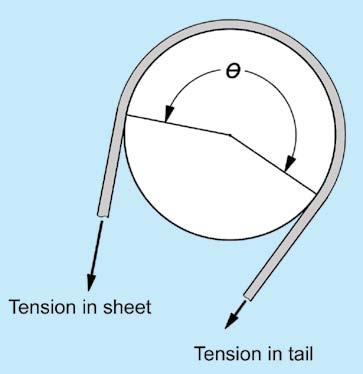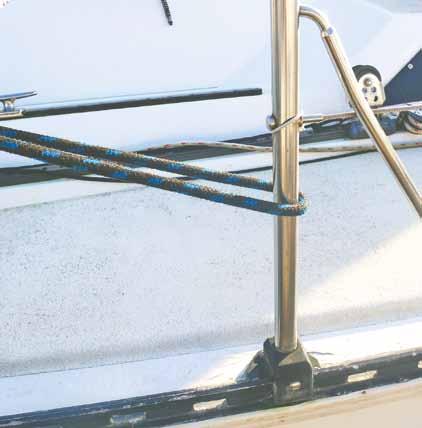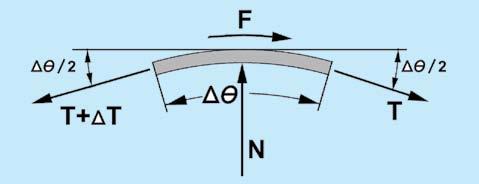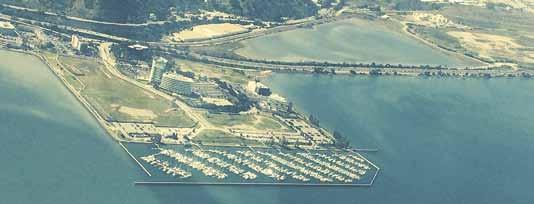
10 minute read
max ebb: do the math
Lee Helm hardly seems to have time to crew for me on my boat these days. Between her windsurfer and her thesis she just doesn't seem to have any extra time. So for the last Midwinter race, I gave up fi nding my own crew and decided to accept a ride on a bigger and faster boat. And, as luck would have it, Lee showed up on the same boat for the same race. "Lee!" I confronted her. "I thought you said..." "Chill, Max. My midterm got moved, so it turns out, like, I was free this weekend after all." But the truth was that this boat is bigger and faster and newer than my boat, and probably serves better sandwiches too. After all, I had made essentially the same choice as Lee. She was given the trimmer's job, and I was assigned to forward 'pit. The race was going well, but with a new sea breeze fi lling in from a new direction, our fi rst downwind leg had turned into a hot reach. Lee was trimming, so she moved the sheet over to a windward halyard winch from which she could see the curl of the spinnaker luff. Another crew jumped in to grind for her as the wind continued to build. "Another wrap, please," Lee asked the grinder. "Use the big winch!" shouted the skipper. That little halyard winch won't hold nearly as well as the primary. The big winch has a much bigger drum." "Not true," she yelled back, without looking down from the sail. "Holding power is equal to E-to-the mu theta, where mu is the friction coeffi cient and theta is the angle of contact. The diameter, like, doesn't even...Grind! ...appear in the formula." "I think the big winch does hold better," I said, agreeing with the skipper. "More bearing area." "Do the math," Lee challenged. "Area is pi times diameter times height of the drum," I replied. "More area equals more holding power. Right? Right?"
Advertisement
The illustration below shows sheet tension and tailing tension, as well as the wrap angle on a winch's drum.
"Wrong," she stated fl atly. "Derive the formula and see what you get. I always have an uncomfortable feeling when Lee tells me I'm wrong about something I had always held to be true. But there was no time for more debate, the leeward mark was coming up fast. Once we were cleaned up from the douse and mark rounding, I found myself sitting just aft of Lee on the rail for the long beat back to the top of the course. "Time for our math lesson," Lee warned as she took out a small notebook and a pen. "What, you're going to prove that winch diameter doesn't matter?" said one of the several foredeck crew who were sitting on the rail just forward of Lee on the opposite side of her from me. "It's an easy proof," she said. Here's the setup." She drew a top-down picture of a winch drum with a rope running most of the way around it. "Clockwise, stupid!" joked the foredeck crew when he saw that she was drawing the sheet load force on the right and the tailing force on the left. Lee quickly corrected the faux pas. The reversed diagram was much more to our liking. "Here's the tension from the sheet load, here's the tension on the sheet tail, and theta is the angle of contact on the winch, in radians. I'm only showing three-quarters of a turn, but if it goes around a full turn that's two-pi, three turns would be six-pi, etc." "Don't you want to use R for the radius of the winch?" I asked. "Don't need it, and you'll see why. Let's look at a small but fi nite section of the sheet as a free-body diagram."

Next she drew fi gure two, showing only a small part of the sheet, in contact with the winch drum through only a small contact angle. "The angle of contact is delta-theta. The force on the right side is T, acting downward on the diagram at an angle of theta over two. The force on the left side — remembering that we have a clockwise winch, is T plus delta-T, also acting down at an angle of theta over two. There's a friction force F, acting tangentially away from the sheet load, and there's a normal force N, pushing up." "Shouldn't the rope be pushing down in your diagram?" I asked. "No, it's a free body diagram. We're only looking at forces acting on the sheet. The winch pushes up on the line. Let's add up forces in the X direction, and we get:
(T + T) Cos( /2) = F + T Cos( /2)
"The angle from horizontal is deltatheta over two, the horizontal component is the cosine of that angle. We have T plus delta-T on one side, and the frictional force plus T on the other side." "Fair enough. Now you do the vertical forces?" "For sure. We have:"
(T + T) Sin( /2) + T Cos( /2) = N
"Where N is the normal force acting up on the line. It has to be equal to the downward components of T and T plus delta-T, both times the sine of one-half theta." "I'm still with you," I said. "Now make the theta angle small, but


it's, like, of a smaller order than the other terms, and it's approximately zero. We're left with:"
T = N
or
= N/T
"I'm not so sure about that one, but I'll go along with it for now." "Cool!" Now we need the relationship between N and F, or the normal force and the friction force. This is just the coefficient of friction, usually abbreviated by the Greek letter mu. We get F = mu times N:"
still fi nite. Cosines go to approximately one and sines become approximately equal to the angles, that is, like, as long as angles are expressed in radians, which they are. So we get:" (T + T) = F + T
A quick way to estimate friction coeffi cient between sheet and steel, F = µN
without moving from the windward rail: Wrap a sheet a half turn around
a stanchion, pull at right angles to the stanchion, then angle slightly up "Substitute this or down. The tangent of the angle at which the bight of rope starts to slip back into the equa-is the friction coeffi cient. tion for the force on the X-axis, and we get:" T = µN "Okay, " I said after giving this some more thought. That's also kind of reasonable. It just says that the change in "Take the limit as the deltas approach zero, to change to the differential:"
dT/d = µ T
"and then solve this differential equation by separation of variables:"
dT/T = d µ
"Integrate both sides from the beginning of the contact angle to the end, so T is integrated from the tailing force to the sheet force, and angle is integrated from the fi rst contact angle to the last contact angle."
T sheet angle at end of contact dT/T = d µ T tail angle at beginning of contact
"Wait a minute!" protested the foredeck crew. "Can you do that, integrating both sides of an equation between different limits? Seems a little hokey to me." "No prob," said Lee. "Physically, I'm integrating over the same limits," Lee tried to explain. "The tailing load increases to the sheet load over the same range of angles that's in contact with the winch drum. So it's the same integration, but just in different variables." The foredeck crew was skeptical, but Lee kept on going. "Integrate one over T with respect to T, and you get natural log of T. Integrate d theta, and you get theta. Plug in the limits of the defi nite integrals, and now we have:"
ln(T-tail) - ln(T-sheet) = µ
"Subtract T from both sides, and we have:"
T = F
"I could have told you that," I said after studying Lee's diagram." "For sure, it's intuitive so far," she agreed. "In the Y direction," Lee continued, "we have:"
(T + T) ( /2) + T ( /2) = N

"Distribute and simplify, and it becomes:"
T + ( T) ( /2) = N
"And there's a tricky part here: We can ignore the ( T) ( /2) term because it's the product of two small quantities, so tension is friction coeffi cient times the normal force." "Now combine the two equations by dividing one by the other."


T/ = (µN)/(N/T) or
Consider a small piece of the sheet on the winch drum as a free body diagram. Forces in the X direction and the Y direction are in balance.
"Subtracting two natural logs is the same as the log of the quotient. And we can also simplify the subtraction of the start and end angles over the defi nite integral to just be the angle of contact. Now we have:"
ln (T-tail/T-sheet) = µ
"And fi nally, remembering the defi nition of the natural log, exponentiate both sides. That is, take e to the power of both sides. That wipes out the natural log on the right side and puts the exponential on the right side. And voilà!"
(T tail)/(T sheet) = e µ
"Except that the tail load is always less than the sheet load. If the exponent is positive, the ratio will always be greater than one." "Okay, Max, good catch. I lost a minus sign somewhere. Sheesh. It's really:"
T sheet / T tail = e µ
Lee was right again. Winch drum diameter has nothing to do with holding power. It's just the number of wraps. "Okay, what does this mean in realworld terms?" I asked. "What's a typical friction coeffi cient for line on a steel winch drum?" "Not hard to get an approximate answer," Lee said as she took a bight of spinnaker spectra afterguy and wrapped it around a steel stanchion. "Apply some normal force, apply some tangential force, and estimate the angle that causes the rope to slip. The tangent of that angle is the friction coeffi cient." We didn't have a protractor handy, but consensus from those of us on the windward rail was that the rope slipped up or down the untapered part of the steel stanchion when pulled at about a 20° angle. "For the friction of jibsheet on aluminum you can do the same test around the spinnaker pole," Lee suggested. "For 20° I get a friction coeffi cient of 0.364," said the foredeck crew, who knew how to use his waterproof phone as a scientifi c calculator. "That means that for one 360° wrap, or two pi radians, the ratio of sheet load to tail load is... let me see, there and e-to-the-X function in here somewhere... 9.85." "That means that each wrap," I ventured to predict, "reduces load by a factor of about ten. With a 4,000 pound sheet load, one wrap brings it down to 400, two wraps to 40, three wraps to four pounds. I can believe that, but I think our winch drums have more friction than the shiny steel lifeline stanchions." "It's exponential, so it makes a big difference," Lee pointed out. "If the coeffi cient of friction is more like 0.5," added the guy with the calculator, "then each wrap reduces the tailing load by a factor of 23. After three wraps that 4,000 pound sheet load is down to less than a third of a pound needed to hold the tail."
"Ready about!" came the call from the helm. "We'll want the reacher on the next leg. Bear-away set!" That ended the physics lesson. But for the next leg, Lee had the spinnaker sheet back on the big winch. "Don't want to overload the bearings," she said.
— max ebb

Discover Brisbane Marina Discover Brisbane Marina
Brisbane Marina – Newly Dredged! ...and the depth in the fairways and channel is 8' at MLLW. Come check out the difference – this is an awesome marina!
GREAT LOCATION! Just minutes to Central Bay sailing.
GREAT STAFF!
GREAT RATES! Starting at $7.28/foot! MARINA GREEN with picnic/BBQ areas and Bay Trail access.








